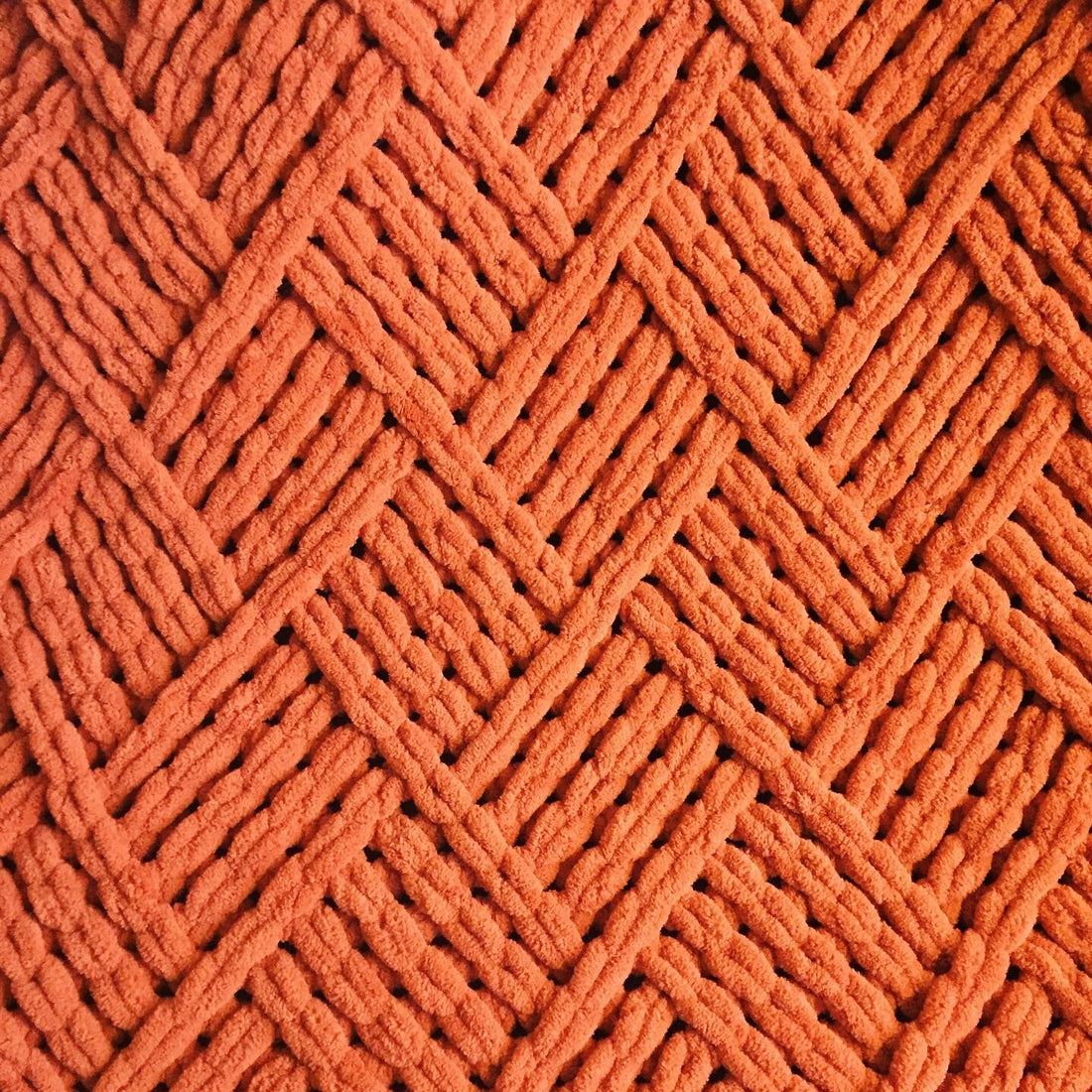
10 Tips to make your Loop Yarn Knitting easier (and better!)
Share
1. Knit instead of Purl
Performing long stretches, or even multiple rows of purl stitches can be tedious. They don't just flow through the fingers the way knit stitches do. Unfortunately, if your pattern calls for them, they're unavoidable. But why purl when you can knit?
A purl stitch is just a backwards knit stitch!
If you flip your project over and knit your loops on the other side, they will look like purl stitches on the front side. Just remember to turn your project back to the front side when you finish your knitted loops, before continuing with the rest of your pattern instructions.
2. Fix the Stitches, Not the Rows
If you notice an error in your design a few rows back (maybe you crossed over left when you should have crossed over right), there's no need to frog entire rows of loops. You can just undo the loops in the rows above the problem areas, correct your mistake, and then re-stitch the loops all the way back up.
If you are following a pattern template, redoing your columns of loops should be fairly easy. If not, make sure to make a note of what the stitches were for the loops you are undoing, so that you don't get mixed up on your way back up!
This video by The Crochet Crowd gives some examples of fixing stitches this way:
3. I Missed a Loop!
So you added an extra loop or missed knitting a loop and didn't notice until several rows later (or maybe not until you finished your project) - Do you need to frog your rows and go all the way back to your mistake?
The honest answer is: maybe.
If you are knitting a simple knit and purl blanket that doesn't have a very complicated pattern, your mistake may not be that noticeable, and there are ways to incorporate un-knitted loops into your project to hide your error.
This blog post by It's Always Autumn has a video with some good troubleshooting tips for fixing those extra loops: 'Loop Yarn For Beginners {Everything You Need To Know!}'. (If you scroll down to her section on 'How to use Loop Yarn', the second video shows you exactly how to reincorporate the missed loops.)
But if you are following a more elaborate pattern that requires a specific order of stitches and counting loops to make it look right, then missed or added loops may cause problems for you, because you now have either too many or too few loops in your rows and the numbers won't add up! So yes, unfortunately, you'll probably need to redo them.
On the plus side, because you do have to count loops for fancier patterns, you'll probably notice your error within a row or two, so going back and redoing those rows shouldn't be too time-consuming.
4. Double-Check Your Skein Size
Loop yarn is now available through many manufacturers, and while they are all very similar, there are size and texture differences between brands. (To get an idea of which loop yarn brands are available by country, see our Where to Buy Loop Yarn guide.)
Each brand of loop yarn should have the skein dimensions listed on the packaging, including the skein weight in grams and ounces, and the skein length in metres and yards.
Loop yarn skein sizes differ across brands, so how many skeins you will need for your project will vary. If you are substituting yarn, the difference in skein sizes may mean you need more or fewer skeins - our Loop Yarn Conversion Chart can help you calculate the different number of skeins you'll need.
While each manufacturer tends to have standard skein sizes by brand, be aware that sometimes different sizes of skeins of the same brands can be sold in different markets. So what you get when buying from vendors on Etsy, Amazon, EBay and AliExpress may be smaller or larger than what you were expecting.
Always read the listing descriptions thoroughly to avoid costly mistakes!
5. Be Careful When Mixing Brands
Mixing different sizes of loop yarn may cause the rows of your project to squish and stretch. You may be able to accommodate these size differences by increasing or decreasing stitches, but it will inevitable alter the uniform look of your finished pattern. (To compare the differences between the major North American brands of loop yarn, see our blog post 'Loop yarn sizes: How do they compare?')
6. All Stitches Are Not Created Equal
When you have a certain size requirement for a blanket and are estimating how much loop yarn you will need to buy (and how many loops you will need for your starting row), keep in mind that using special stitches may squish the width of your finished blanket.
While knit and purl stitches give you a finished blanket of essentially the same width, criss-cross stitches will reduce the width, and chunky cables will decrease it even more substantially. Blankets and other projects that have a lot of these special stitches will need a greater number of loops in your starting row to achieve your intended width.
7. Bind Your Edges
Binding your edges really gives your project a nice finished look, and actually makes the edges of your blankets and clothing items more secure and less vulnerable to fraying.
For blankets or other projects where you finish with a final row of loose loops, binding (also known as casting off) is necessary anyway, so why not continue that around the other edges too? Binding your edges is also a great way to get your project to lay flat (especially with all-knit stitch blankets that want to curl).
If you don't want to bind all four sides of a blanket or other project (like a scarf) and just want your top and bottom edge to match, there is a way to *start* your project with a bind-off as well!
This video by GoodKnitKisses shows how to count extra loops to bind your starting row (from the 9:30 mark):
8. Don't Start Over. Add A Border!
So you finished your blanket and it's too small - should you rip it all out and start over? You could, but that feels like a lot of hard work wasted! And maybe your miscalculation has also resulted in a limited number of skeins of that colour - what then?
Instead of frogging your blanket - add a border! You can add a border of the same or a different colour around all four sides (or even just the left and right side) but feeding loops through the edge of your blanket and building rows vertically outward. Now you've turned your design 'oops' into something unique!
9. Hooks Are Okay!
We get that the point of loop yarn is to be needle- and hook-free, but maybe that just doesn't work for you! Especially with the smaller-gauge loop yarns, using your fingers can be fussy. If you got into loop yarn knitting because of dexterity issues (maybe you have arthritis, or maybe you just have gorgeous chubby digits!), there is no reason you should be suffering for your craft. You're allowed to do whatever you can to make your crafting easier and more enjoyable!
I use a metal crochet hook (size J) when I'm working with double-stranded loop yarn (like Alize Puffy More) to pull my loops through. You could just as easily use a larger hook for larger loop yarn, but you might need something bigger.
10. Sometimes Four Eyes are Better Than Two
Crafting should be something that you enjoy, not a source a constant frustration. If something isn't working for you, there might be a different or easier way to approach it - which leads to the most important tip of all - ask for help! Whether it's your local knitting group or online, other people can be one of your greatest resources.
Sometimes all it takes is a fresh set of eyes to figure out where you're going wrong. We've all had those moments where we stare at something helplessly for an hour, only to show it to someone else and have them point out the problem in 30 seconds!
I hope these tips have helped! Do you have any tips or tricks with loop yarn that you wish someone had shared with you? Share them below!


3 comments
I always make copies of the pattern and mark off the stitches and rows as I go along. This keeps me on the right row and stitch. I know it seems a bit of a pain but it keeps me from having a lot of errors.
Great tips, Adrienne!
What I’ve found useful when following a pattern is to have a stitch counter. That way whenever I stop and start again I know exactly where I am in the pattern and what row to start. Its especially helpful when you have a pattern that calls for repeated stitches from previous rows. ( ex: row 20 repeat like row 3). I also use safety pins on the first and last stitches in my row. That way I can keep count of my stitches, especially when following a pattern. If I’m supposed to have a cross stitch and then end with a knit stitch and I only have two stitches left I know that I have a missed stitch in that row. Hopefully I explained that clearly. 😊